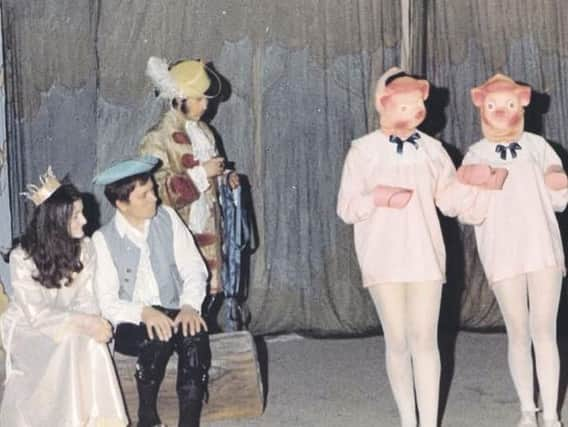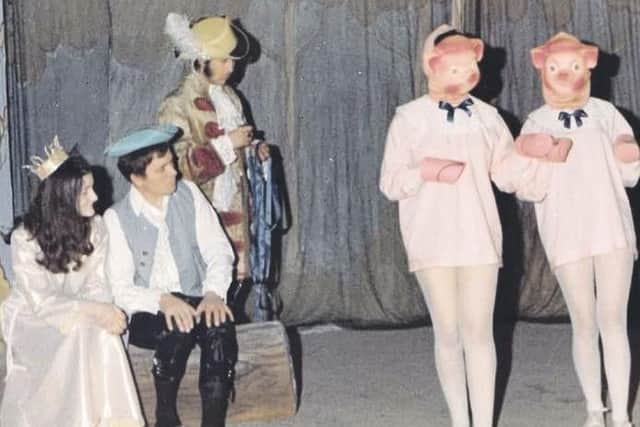Battered by storm but not broken, theatre finally fell to arsonist


Nestled in Tilgate Forest in one of the Nissen huts previously used by the Canadians during the Second World War, it offered entertainment and some rather excellent acting.
The great storm of 1987 did its best to end things when a huge tree crashed down through the hut. But the team rebuilt and trod the boards for another 17 years before an arsonist brought down the final curtain.
Advertisement
Hide AdAdvertisement
Hide AdOne of the many amateur thespians to take to the stage was Joy Potter (formerly Pitcher), of Ifield.


Joy was part of the team when the storm of ‘87 struck.
She said: “After the great storm drove a huge tree through the theatre, almost destroying it, we were eventually given a new building, just a shell, to house our beloved theatre.
“We were able to salvage some of the important items, like the old cinema seats which had been donated many years before. In fact most of our props and many costumes were saved.
“We set to as a group to rebuild the stage and furnish our beloved theatre with all the necessary equipment, many of our weekends being taken up with this task.
Advertisement
Hide AdAdvertisement
Hide Ad“Eventually all was complete and off we went with our first play in 1991.
“All was good and we flourished, almost always having a full house especially for pantos which were much loved by local children not to mention the cast!”
Joy was recruited into the theatre in 1982 by Mrs Pearl D’Alvarez, who she said is now living on the Isle of Wight.
She said: “It was a great, exciting part of my life and something I wouldn’t have missed for the world. We attended two or maybe three Crawley carnivals and had our own float.
Advertisement
Hide AdAdvertisement
Hide Ad“Many friendships were formed and some of us ladies are still together and meet up on a regular basis having formed the Red Hat Society – proudly known as Crawley Red Titfer Tats – where we dress in purple with red hats and do all sorts together.
“I often remark that its like a panto when we go out on our jaunts!”
Disaster struck one night in 2004, when the theatre was all set up for its next play. After bringing years of joy to the people of Crawley, its story ended in tears at the hands of an arsonist.
Joy said: “We had all worked so hard to re build our new theatre, and it is true to say that many hearts were broken that night.
Advertisement
Hide AdAdvertisement
Hide Ad“To say we were devastated is an understatement. We gathered at the burned out remains and a photograph was taken as we stood among the ruins.
“To us it was a bereavement of sorts.
“Friendships had been formed among the group, and many of us still meet up to this day. But our theatre was never resurrected and I don’t think any of us would have wanted it to be.”
Keen to keep a record of her years at the theatre, she created a collage of clippings and photos.
Joy said: “Sadly the news cuttings are old and yellowed, and the whole thing has seen better days, but it is a very precious keepsake which I am proud to have on my wall.”
Advertisement
Hide AdAdvertisement
Hide AdOne of the founder members was actor, producer and jack of all trades, Peter Sheridan, whose family donated many pictures of his theatre days to Crawley Museum.
They included The Day After The Fair by Frank Harvey, which was first produced in the Lyric Theatre, London, in October 1972.
The action took place in the front room of the Brewers Arms, in a west country cathedral city.
The players were: Peter Sheridan as Arthur Harnham, Pat Smith as Letty Harnham, Pamela Leszczar as Edith Harnham, Sandra Thomas as Sarah, Deidre Humphreys as Anna Dunsford and Robin Keyte as Charles Bradford.
Advertisement
Hide AdAdvertisement
Hide AdThe programme listed Graham Branch as stage manager, properties by Vivian Short, continuity by Pat Wilmer, sound by Alfred G Jeffrey and lighting by Cliff Hudson.
Then there was Bullen, written by Eric Gooch. It was staged in the early 1970s and, according to one reviewer, highlighted the “chill reality of 16th century life”.
The reviewer stated: “If anyone went to the Tilgate Forest Theatre thinking they were going to see a pretty-pretty period play they were in for a rude awakening. For Eric Gooch’s historical piece, Bullen, wasted no time in getting down to the harsh realities of life in the days of King Henry VIII.
“From the moment the curtain went up to the eerie note of an owl hooting and a blood-curdling scream of a 16th century poacher with his arm caught in a trap, the Crawley repertory company held their audience’s undivided attention while they unfurled the drama of the ill-fated Bullen, or Boleyn, family of Rochford and Hever.”
Advertisement
Hide AdAdvertisement
Hide AdThe play starred Peter Sheridan as Thomas Bullen, Vincent Humphries as John (his steward), Vivian Short as Anne Boleyn and Brian Riddle as Henry VIII.
Hans, The Witch and The Gobbin was a two-act play staged c1971 and was billed as “a play for children by Alan Cullen”. It was set “many years ago” in a Royal park, a room in the palace of King Rufus, the forest and the Queen’s grotto.
The cast included Lee Brooks as Gob, Janet Revell as Hank, Janet Sidey as Hunk, Dave Terry as Sylvester and Pam Lesczar as Queen of the Forest.
Production was by Peter Sheridan, lighting by Ken Moth and properties by Janet Slater, while Tom Ricketts was in charge of Front of House. The set was designed, built and painted by Peter Sheridan and Jack Allen.